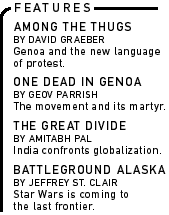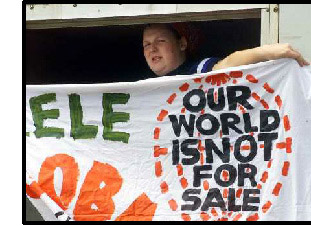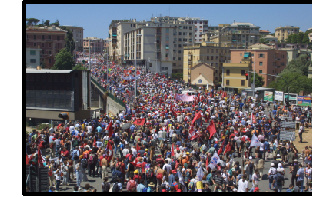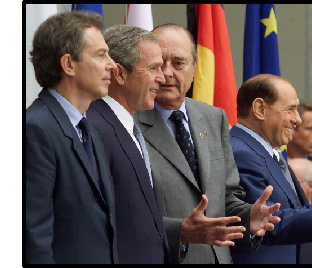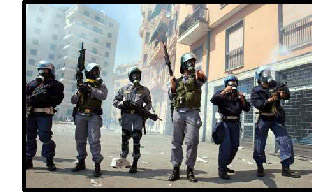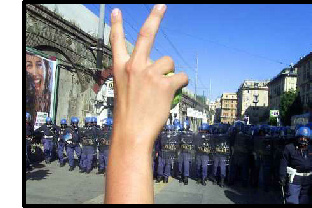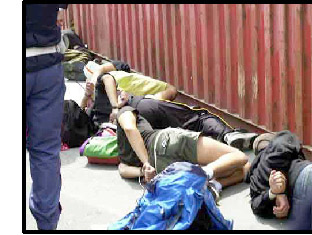|
|
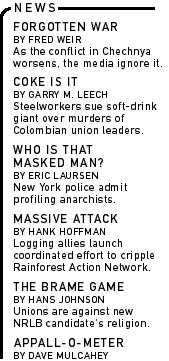
|

|

|
|
|
| |
|
|||||||||||||
|
For some 20 months, from Seattle through Washington, D.C. and Melbourne and Windsor and Philadelphia and Los Angeles and Prague and Davos and Quebec and Gothenburg, tactics have been escalating on both sides as the protests against gatherings of the world's political and economic elites have grown larger and more raucous. In Seattle, some 50,000 nonviolent protesters and blockaders, enraged by international institutions that exacerbate global poverty, environmental destruction and the loss of democracy, were overshadowed by a few dozen window-breaking vandals. By the time of Quebec and Gothenburg, large blocks of protesters had come to tolerate property destruction, and the hurling of everything from teddy bears to Molotov cocktails, to make their points. On the police side, the brutality that shocked the world in Seattle was actually a step
whether they were breaking any laws or not--has, at least in the public eye, become old news, an acceptable price to pay to keep the "hoodlums" at bay. The media surely have helped; in Quebec and Gothenburg, the worst of the police mayhem was best reported not by the combined resources of the world's elite media, but by www.indymedia.org. The U.S. networks almost uniformly ignored it, blaming the victims of police violence. And now, in Italy, a man is dead.It was coming to this. Perhaps more telling, even, than the death of 23-year-old Genoa anarchist Carlo Giuliani at the hands of a terrified paramilitary conscript three years his junior, are the hundreds of serious injuries that occurred as Italian security forces launched repeated, unprovoked attacks on G8 Summit protesters. Of the 150,000 or so estimated to have gathered on the streets of Genoa, all but about 2,000 are thought to have been committed to the nonviolence pact agreed upon in advance by the Genoa Social Forum, a coalition of some 1,300 groups that was an umbrella group for many of the protests. It didn't matter. Italian authorities, working closely with U.S. and other police agencies, dramatically escalated the levels of violence with which these protests, now inescapable at international summits, would be met. There are numerous chilling accounts of the contempt for civil liberties and human
When the weekend was over, each side saw what they wanted to see. Establishment politicians and media, as well as a few of the more moderate protest groups, railed against violent protesters bent on disrupting the gatherings of democratically elected leaders. But it was individuals who engaged in the thuggery and vandalism; the pools of blood and a dead body were the calculated work of 20,000 public employees. Those are the images that will resonate. Genoa is reminiscent of nothing so much as Kent State, where, after (at least) hundreds of thousands of deaths in Southeast Asia, it took the deaths of four young, privileged American students on a Midwest campus in May 1970 to galvanize opposition and transform the U.S. anti-war movement into a force that shut down campuses across the country. At the time of Kent State, public opinion, shaped by contemptuous politicians and judgmental media, was that the guardsmen acted properly and the Kent State students were anti-American thugs who had it coming. This time, unlike at Kent, the violence was planned and approved by the highest levels
invoking cops who brutalized thousands without provocation. Such dangerous, menacing behavior--intended as much to dissuade future demonstrators as to control crowds at Genoa--is likely to continue to escalate until it proves either politically ineffective or no longer necessary. Global justice activists may be in shock after Genoa, their largely abstract concerns (at least in the Western countries where these protests have blossomed since Seattle) grounded by the realization that they, too, could be shot for their opinions. In the Third World, of course, this has been the reality for decades, with the grave sites to prove it. And, as in the Third World, the threat will not suppress the movement. George W.
In the face of escalating security measures, global justice advocates have managed to
oriented gestures that are grossly inadequate but still far better than could have been imagined two years ago. They have broad public support in some parts of the world, especially in the Southern Hemisphere. In Bush, like Ronald Reagan before him, the world sees an ignorant American fool with terrifying power; and Dubya, unlike Bonzo's buddy, has no competing superpower to either slow him or scare allies into submission. Bush's friendly, arrogant, clueless face may turn out to be the best recruiting tool global justice activists ever could have wanted. But is public opinion enough? As enraged activists rightly charge, supranational
We saw, a dozen years ago, how rapidly a popular movement can take hold and shake a world. More than 30 countries experienced nearly entirely bloodless revolutions in the span of a few months in 1989-1990, and nobody saw it coming. The people in those countries were often responding to generations of cruel repression, but they were also rebelling against forces thought to be impervious that proved (except in Beijing) to be deadly but paper-thin. And in 12 years, there have been vast changes in the speed with which the planet can be circled by information, tactics, inspiration and images like a dead Genovese man in the street. The global justice movement may be on the cusp of something, but nobody seems to
But even as American activists point toward IMF/World Bank meetings
in Washington from September 28 to October 4, they must start envisioning
beyond the street warfare. What must emerge are not ideologies or
utopian blueprints, but practical, just, achievable and necessarily
imaginative solutions to vexing problems and conflicting needs--and
ways to make those solutions visible, understandable and desirable
to the public. It's a tall order. But if activists show that an
entire constellation of global policies is fundamentally flawed,
and don't give others a clear idea of what they want instead and
how to get it, somebody else will fill that vacuum. And it won't
be good. Now read David Graeber's report from Genoa, "Among the Thugs."
|




